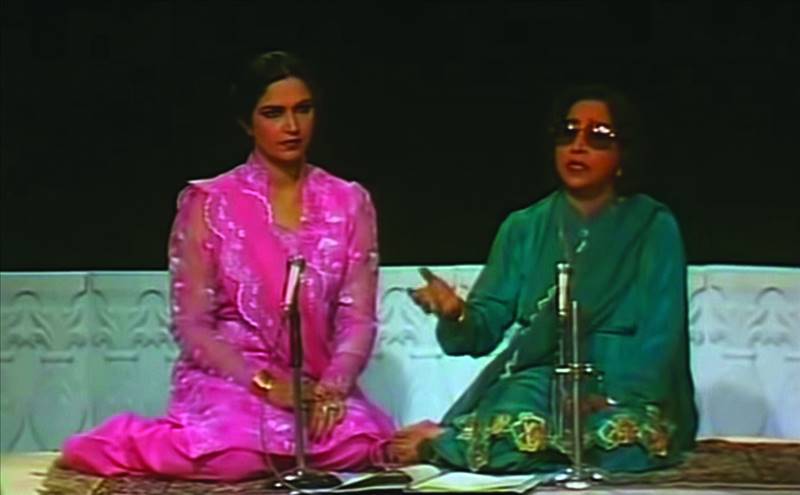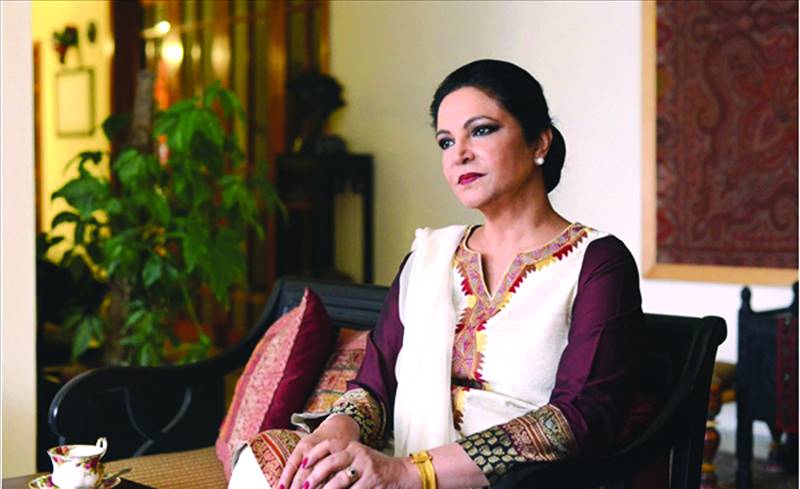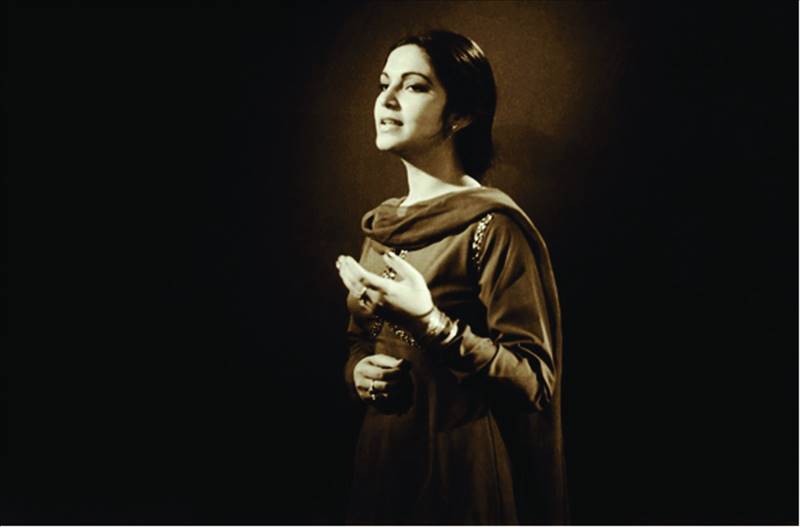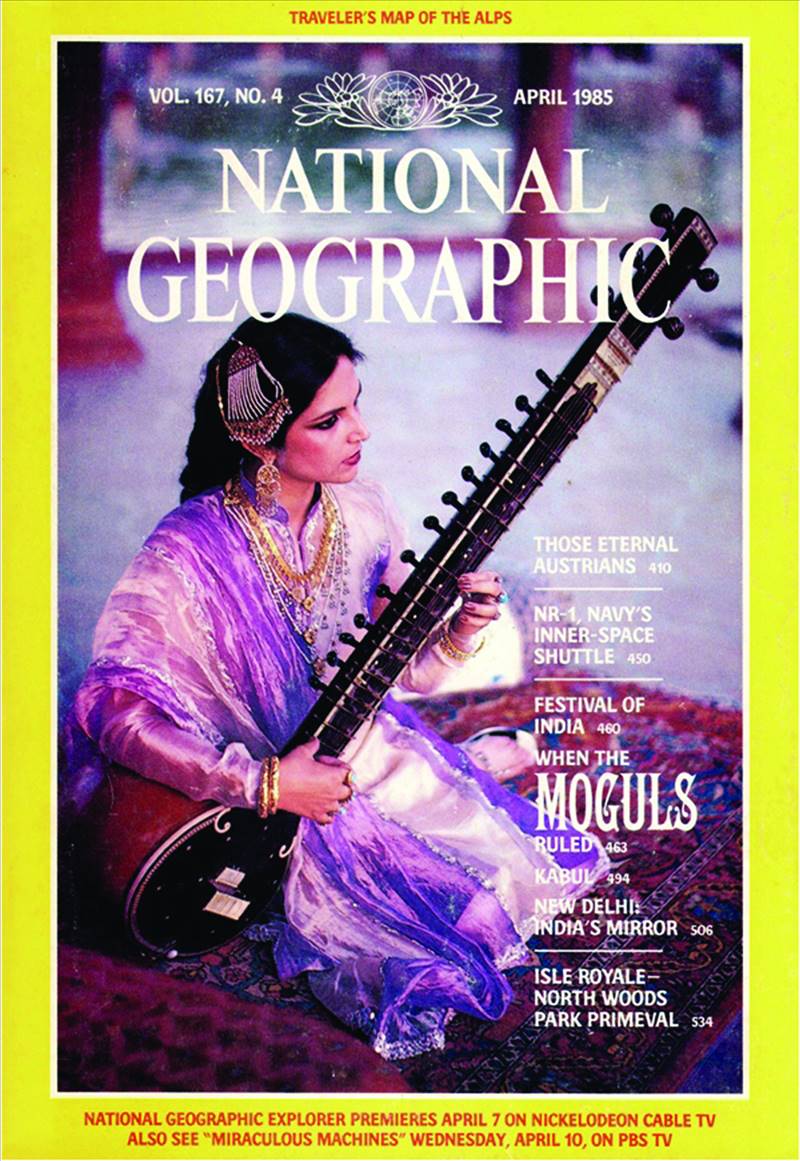
Tahira Syed’s
Top Ten Favorite Songs
by
Haroon Shuaib
One of the finest singers of Pakistan, Tahira Syed is a woman of immense talent, tremendous beauty and great intelligence. Influenced by both classical and folk music, Tahira sings in a distinctive style that has enjoyed popularity for more than four decades. In an exclusive article for the Friday Times, the enchanting songstress talks to Haroon Shuaib about her favorite songs.
Music has been an important and integral part of my life for as long as I can remember. I have great love for literature, poetry, cinema, television, and art but my passion for music outweighs all other interests. I listen to music all the time and cannot imagine a life without music. Selecting ten pieces of music for an article about my favorite songs is not an easy task. An exceptionally large number of factors make a good song – creativity, novelty, originality, musical merit, vocal quality, poetic content, and intellectual worth, to name a few – but the one that I used to select songs for this article was nostalgic value. These ten songs evoke important memories, emotions and feelings, are close to my heart, and intimately linked to my life, soul and person.

Jindhri Lutti Tain Yaar Sajan Kadi Mor Maharan Te Aa Watan
Vocals: Bare Ghulam Ali Khan
Lyrics: Khawaja Ghulam Farid Koreja
Music: Bare Ghulam Ali Khan
My mother, Malika Pukhraj, had great fondness for Bare Ghulam Ali Khan and not only because of his music. He was the son of Ali Baksh Khan Qasuri, one of her four teachers of music and, as such, very dear to her. Bare Ghulam Ali Khan’s music used to play in our home at all times. Mummy loved all of his music but seemed to like Khawaja Ghulam Farid Koreja’s rohi (روہی), Jindhri Lutti Tain Yaar Sajan Kadi Mor Maharan Te Aa Watan, the most. My father’s passing affected everyone in the family greatly, but my mother’s pain was the most palpable. In those sad times, she seemed to find solace in this song. Not one to show her emotions easily, she would often break down in tears while listening to the rohi. As a child, it was unsettling to see my mother cry; yet, at the same time, I felt a strange sort of relief seeing an emotionally vulnerable side of her personality that she had, heretofore, kept hidden from her children. The memories of the song playing on the radio are deeply etched in my mind and evoke a plethora of emotions, simultaneously sad and happy, every time I listen to it.
“Mummy had many friends in the signing fraternity and Iqbal Bano was also very close to her. She once requested Mummy to visit her house; I also tagged along. There she made us listen to a new piece that she had recorded. It was ‘Dasht-e-Tanhai’”
Hun Apne Aansoo’on Ka Afsana Kya Sunayein
Vocals: Malik Pukhraj
Lyrics: Ahmed Faraz
Music: Master Inayat Hussain
In the nineteen fifties, Mummy produced a film titled Shammi under the banner of Malika Pictures. A Santosh Kumar – Shammi starrer, the film was written by Baba Alam Siyah Posh and directed by Munshi Dil. Mummy oversaw the production of the film in her signature authoritarian style, paying special attention to the film’s music, which was composed by Master Inayat Hussain. The film had nine (9) songs but her favorite was the duet, Majboor Zindagi Ka Afsana Kya Sunayein, which she sang with Inayat Hussain Bhatti. She loved the song and wanted to record a ghazal in the same tune.

My father, Syed Shabbir Hussain, known to most people as Shah Ji, had great love for literature and poetry. Writers and poets used to frequent our house and were treated as members of the family. Ahmed Faraz was particularly close to my parents and came over often for tea and meals. During one of these visits, mummy hummed the song Majboor Zindagi Ka Afsana Kya Sunayein and asked him to write a ghazal for her in the same zameen (زمین). He wrote the ghazal on the spot and mummy recorded it in 1986 for PTV’s program Aap Ki Pasand. It is very dear to me because it was written especially for my mother and brings backs memories of a wonderful childhood spent in the company of some of the finest writers and poets of the era.
Mere Humnafas Mere Humnawa Mujhay Dost Ban Ke Dagha Na De
Vocals: Akhtari Bai Faizabadi
Lyrics: Shakeel Badayuni
Music: Akhtari Bai Faizabadi - Khayyam
A lot of people refer to Akhtari Bai Faizabadi as Begum Akhtar but to my mother she was always Akhtari. Two years older, mummy considered her a younger sister and dear friend. She had great memories of them performing together in All India Radio programs and had a large collection of Akhtari Bai vinyl records that she played with great celebration in our home. One of mummy’s – and my – favorite Akhtari Bai ghazals was Shakeel Badayuni’s Mere Humnafas Mere Humnawa Mujhay Dost Ban Ke Dagha Na De. Composed in the somber raag Darbari (درباری) but set to the playful taal Mughlai (مغلئی), the ghazal covers a wide range of emotions, happy and sad, and possesses a poignancy that stirs the listener’s soul. I was drawn to the ghazal when I first fell in love. My emotions resonated with those of the ghazal which, I came to believe, had been composed just for me. It is the one song that I sang for my ex-husband, Naeem Bukhari, most often. Today, it brings back the best memories I have of my marriage and takes me to an incredibly happy, if emotionally raw, place.
Tahira breaks into an honest laugh, “Mummy had her own peculiar ways. She was not easily impressed and usually did not reveal much”
Main Hun Mushtaq E Jafa Mujh Pe Jafa Aur Sahi
Vocals: Noor Jehan
Lyrics: Mirza Assadullah Khan Ghalib
Music: Hassan Latif
Noor Jehan and Mummy had a great friendship. The two had a shared love for poetry, music, food, and the finer things in life, and held each other in high regard. As a child, we visited Noor Jehan’s home often and enjoyed what was truly lavish hospitality; when she chose to be one, there was no host more gracious than Noor Jehan. I became a close friend of her eldest daughter, Zill E Huma during the heady, carefree years that we spent at the Lahore College for Women. We shared stories, gossip, secrets, worries, and, of course, music. Zill E Huma often brought records of her mother’s songs to college to play for her friends. I heard Main Hun Mushtaq E Jafa Mujh Pe Jafa Aur Sahi, for the first time, on one such occasion, and immediately fell in the love with the song. Mirza Ghalib’s poetry, of course, was masterful but Noor Jehan’s rendition, which added layers of meaning to each couplet and brought it alive with a pathos that only she could muster, gave the song the emotional and intellectual heft that I found matchless. I have been a fan of Noor Jehan’s music and larger-than-life persona all my life and love dozens, if not hundreds, of her songs. Yet, it is easy for me to pick this ghazal as my favorite Noor Jehan song; it speaks to me as few others do.
Ab Ke Hum Bichray To Shayad Kabhi Khawabon Main Milain
Vocals: Mehdi Hassan
Lyrics: Ahmed Faraz
Music: Mehdi Hassan – A Hameed
Ab Ke Hum Bichray To Shayad Kabhi Khawabon Main Milain introduced me to Mehdi Hassan and Ahmed Faraz – two people that I have held in the highest esteem ever since. I first heard the song when Shah Ji drove us to Muree for a family vacation. It played in the car, in our hotel room at the Cecil Hotel, and at the Lintott’s Restaurant where we spent a lot of time. The memory of our lovely family vacation is inextricably intertwined with that of the song, which is my favorite ghazal of Mehdi Hassan.

Perfect pitch, superb timber, excellent tone, a solid classical base, and the sensibility of a genuine musician – he had it all. Aware of my adoration for his music, Mummy once took me to see him and asked him to give me some lessons in music. He was kind and gracious and gave me sincere instruction that I found extremely beneficial. Even today, I go back to those lessons whenever I do my riyaz (ریاض).
Mehdi Hassan once told me an interesting story about the ghazal. He had composed the ghazal in raag Bhopali (بھوپالی) which employs the sharp variant of the sixth note, Teevar Dhaivat (تیور دھیوت). While he was travelling to the studio to record the ghazal, his car hit a rickshaw causing the harmonium to fall from the seat to the floor. As a result, the tuning of the harmonium got messed up and sixth changed to the flat version, Komal Dhaivat (کومل دھیوت). A lot of time was wasted dealing with the accident and, when he reached the studio, none was available to retune his instrument. Undaunted, he sang the ghazal with the flat sixth, thereby creating a new raag, which he called Komal Dhaivat Bhopali (کومل دھیوت بھوپالی). Indeed, we do not see the raag in Hindustani Sangeet before 1972 and musicians started performing it – variously as Komal Dhaivat Bhopali, Bhupeshwari (بھوپیشوری) and Parteeksha (پراتکشا) – only after Mehdi Hasan’s ghazal became popular.
Aaj Socha To Aansoo Bhar Aaye
Vocals: Lata Mangeshkar
Lyrics: Kaifi Azmi
Music: Madan Mohan
I first listened to Lata Magehskar’s Aaj Socha To Aansoo Bhar Aaye in London. I was seventeen years old at the time and had travelled all over the US and Europe before coming to London. The travel and concomitant pleasures had me intoxicated. It was in this state that I heard the song, which I came to associate it with youth, friendship, love, and coming-of-age. A cousin playing host to me during the vacation in London had recently acquired a car that came with a built-in cassette player – a big deal in the nineteen seventies. He would take me on long drives all over England, playing the song on repeat, as I enjoyed the country’s scenic beauty. The song contributed to a lifelong love affair I have had with England and with travel.
The song has many qualities – Lata Magehskar’s excellent vocals, Rais Khan’s brilliant sitar interludes, Madan Mohan’s outstanding composition – but the skillful employment of a number of raags - Shivranjhani (شورنجھنی), Anandi (آنندی), Sindhura (سندھوڑا), Kafi (کافی), and Jaunpuri (جونپوری) – is, in my opinion, its greatest strength. This lends the song of an emotional gravitas rarely found in film songs. Madan Mohan tried to recreate it with Rukay Rukay Se Qadam Ruk Ke baar Baar Chale in the 1975 Gulzar film Mausam but could not quite reconjure the magic of Aaj Socha To Aansoo Bhar Aaye.
I have heard that Lata started crying uncontrollably when Madan Mohan first sang the song for her. Totally overwrought with emotion, she asked for the recording to be cancelled and came back to record the song several days later. I do not know if the story is true or not but tend to believe it because I know the effect that the song can have on a listener. I admit to having shed a tear or two – and maybe more – while listening to the song, on several occasions.
Dasht E Tanhai Main Ae Jan E Jahan Larzan Hain
Vocals: Iqbal Bano
Lyrics: Faiz Ahmed Faiz
Music: Mehdi Zaheer
Mummy enjoyed the company of musicians and had a lot of friends in the singing fraternity. Iqbal Bano was one of her dearest friends. She once asked mummy to visit her house because she had recorded Faiz Ahmed Faiz’s famous poem Yaad (یاد) and needed her opinion. I tagged along. Iqbal Bano was visibly disturbed when we saw her – Faiz’s poem had become immensely popular after its publication in Dast E Saba (دستِ صبا), in 1953, and she was concerned that her rendition would not meet the high expectations that people had for the song. Mehdi Zaheer’s composition was decidedly unusual; she felt the song did not need the percussion he had added to parts of the composition. She played the song twice for us. I was moved by the powerful poetry and by Iqbal Bano’s powerful, sturdy rendition. I’m not sure if Mummy liked the song or not, but she told Iqbal Bano not to worry because it was destined to be a hit. She was right; the song went on to become the most popular song of Iqbal Bano. I continued to listen to the song in the years that followed and eventually added it to the repertoire of songs that I sing in my concerts.
Haaye O Rabba Naiyun Dil Lagda Mera
Vocals: Reshma
Lyrics: Manzoor Jhalla
Music: Nathoo Khan
Reshma used to visit our home frequently, often staying with us for days on end. Mummy enjoyed listening to her songs and had her singing all the time. Reshma’s powerful voice would reverberate throughout the house and draw everyone in. These were great times in our home – full of laughter, music and happiness. Things changed after Shah Ji passed. Reshma still visited our home but the mood was no longer upbeat. Mummy was depressed, insisted on listening to only one song, Haaye O Rabba Naiyun Dil Lagda Mera, and cried every time Reshma sang it. This made Reshma feel bad, so she vowed never to sing the song again because she did not like to see Mummy cry, only to break the vow a few hour later. People love recordings of Reshma’s songs, but few realize that her music was meant to be heard live and at close quarters. In the right setting, it had the power to move mountains. I am grateful to God for having given me the opportunity of listening to Reshma live. I love all her songs but Haaye O Rabba Naiyun Dil Lagda Mera is particularly close to my heart.
Mann Atkeya Be Parwah De Naal
Vocals: Nusrat Fateh Ali Khan
Lyrics: Shah Hussain
Music: Nusrat Fateh Ali Khan
It is difficult for me to say if I loved the singer Nusrat Fateh Ali Khan more or the person, but, if forced, I would probably pick the person over the singer. I found his innocence, kindness and warmth highly endearing and held him in the highest regard. He had the soul of an angel and sang like one too. I made it a point to attend as many of his concerts as I possibly could and am fortunate to have found a friend in him. He often visited my home and even performed at my daughter Kiran and son Hasnain’s birthdays on multiple occasions, without ever accepting even a penny in fees. Artists of his stature are not always so generous. He really was an angel.
Mann Atkeya Be Parwah De Naal is my favorite song of Nusrat Fateh Ali Khan, probably because he composed it in my favorite raag Jaunpuri. A relatively modern raag, Jaunpuri was invented by Sultan Hussain Sharqi of Jaunpur in the fifteenth century. A raag normally encompasses only one of the nine emotions, the nauras (نورس), defined by Bharat Muni in the Natya Shastra but Jaunpuri is different. Its aesthetics include four ras: playfulness, pathos, beauty and peace. Mummy recorded a chota khayal (چھوٹا خیال) in Jaunpuri that I listen to very often. Noor Jehan’s Ve Lagiyan Di Laj Rakh Layeen, Fareed Ayaz Qawwal’s Sajda Kar Ke Qadam E Yaar Pe Qurban Hona, Lata Mangeshkar’s Dil Cher Koi Aisa Nagma, Alka Yagnik’s Pal Pal Hai Bhari, Talat Mahmood’s Meri Yaad Mein Tum Na Ansoo Bahana, and Ghulam Ali’s Ik Din Tenun Sufna Theesan, I have a special fondness for all songs composed in the raag. Mann Atkeya Be Parwah De Naal is special because it uses the emotional essence of Jaunpuri to bring alive Shah Hussain’s poetry in a song that is hopelessly and unabashedly romantic. I am in love with the song.
Neun La Leya Be Parwah De Naal
Vocals: Hamid Ali Bela
Lyrics: Shah Hussain
Music: Hamid Ali Bela
Hamid Ali Bela was an exceptionally talented singer who, sadly, never got the recognition that he deserved. He started his career in music as a singer of ghazal but Mummy, along with a few others, encouraged him to move to kafi (کافی), a genre better suited to his voice, singing style, intellect, and spiritual makeup. As a singer of kafi, he built a loyal body of listeners but never found the fame and fortune that I feel he merited. I sometimes wonder if he even cared for money and recognition but find it difficult to understand the mind of a man so completely immersed in spiritualism. Fond that I always was of him, I found Hamid Ali Bela inscrutable as a person.
Neun La Leya Be Parwah De Naal is essentially the same as the kafi Mann Atkeya Be Parwah De Naal; the only difference is in the first line of the verse, the mukhra (مکھڑا). Mann Atkeya Be Parwah De Naal has a connotation of involuntary love which is not as delicate as the admission of having voluntarily attached one’s self to the beloved as in Nyun La Leya Be Parwah De Naal. That delicacy is the heart of Shah Hussain’s wonderful kafi. Hamid Ali Bela uses a faster tempo than most other singers have used in their renditions of the kafi. This makes the song celebratory instead of melancholic. That, in my opinion, gives the song its charming, romantic core.
As I look at the list of my favorite songs, I know that it will be different each time I compile it. My mood, emotions and memories dictate the songs that are my favorite on any given day; and, since those change with time, so will my list. One thing, however, will never change. The list of my favorite songs will never include any of my own. I do not enjoy listening to my own music!
Haroon Shuaib is a documentary filmmaker and development communication specialist, based in Islamabad. Furthermore, he writes about culture, art and music for a number of national and international publications. He tweets @hhaarroonn and can be reached at hhaarroonn@hotmail.com

